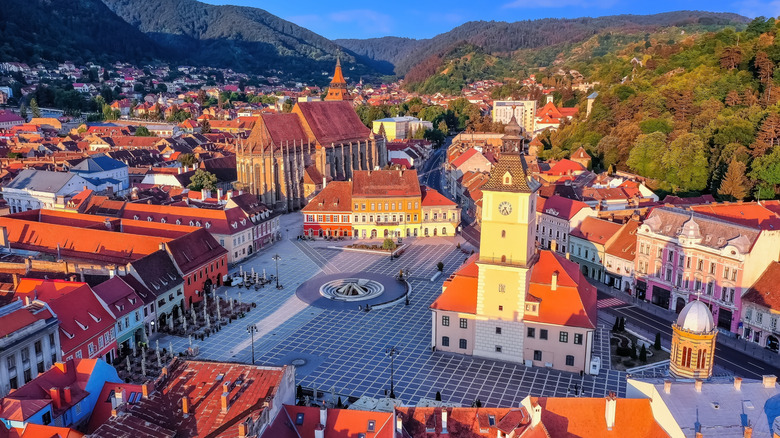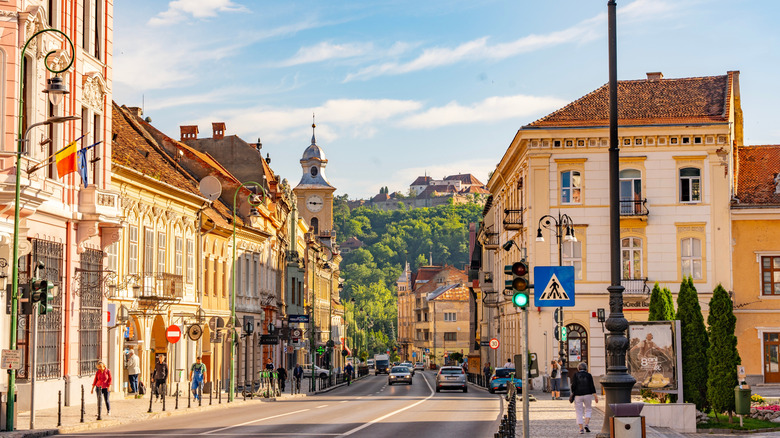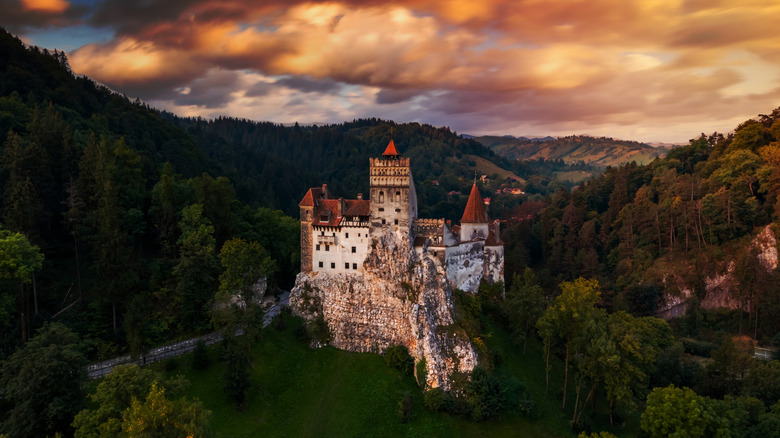The Best Base For Exploring Romania Is A Wildly Affordable, Less-Touristy Fairytale Town In Forested Hills
Charming Brașov is painted in terracotta and old cobblestones across a forested slope of the Transylvanian Alps. While it's in the heart of Romania, you'll find it has more of an old-world Germanic aesthetic, a sharp contrast to Bucharest's striking Neoclassical and Art Nouveau architecture, an unsung city nicknamed the "Little Paris of the East." Indeed, Brașov's roots can be traced back to ancient times, but the town was founded in the 13th century when it was a Saxon colony. But the majority of its old town is from the 15th century, with fairytale watchtowers and ornate churches providing the more eye-catching sights.
Brașov's wonderful green location, set amongst the hills and forested peaks of Transylvania, makes it a perfect and affordable base from which to explore Romania, with the capital, Bucharest, close enough to travel by train. But equally, Brașov enjoys the distinction of being the closest major town to Romania's celebrity castle: the imposing Bran Castle, otherwise known as Dracula's Castle. So it's well placed for exploring the stunning castles and palaces of Romania's mountainous countryside.
While the closest international airport is Brașov-Ghimbav International Airport, 6 miles away, it has only a small collection of connections to European cities such as London and Cologne. A better option for most is to fly instead to Bucharest Henri Coanda International Airport, and from there either travel the two hours by road, or take a direct train from Bucharest to Brașov, which takes around two and a half hours.
The highlights of Brașov's beautiful old town (Centru Vechi)
Brașov's old town, filled with red-roofed merchants' houses, is explorable on foot, and its charming town square, Piața Sfatului, is a good spot to get your bearings. The square is lined with colorful houses like the 15th-century Casa Sfatului (Council House), and cafes spill out onto convivial terraces, particularly popular on sunny afternoons. But the square (and the rest of the old town) is an ideal spot to try some local food specialties too, such as braşovence, breaded pancakes usually stuffed with mushrooms, and bulz, which are delectable meat(less) balls made from polenta with a creamy sheep's cheese filling.
The evocatively named Black Church (Biserica Neagră) is close to the square, its bulky tower peering over the cobbles from over 213 feet high. The church was built in the 14th to 15th centuries, and earned its name from a fire that ravaged the exterior in 1689, leaving its walls blackened from smoke. The interiors are slightly bland, but are brought to life, intriguingly, by a collection of Ottoman rugs and a stunning organ with 4,000 pipes.
Inset in Brașov's old walls, you'll find Catherine's Gate (Poarta Ecaterinei), and while the little towers puncturing blue skies lend it a playful fairytale aesthetic, only the central tower is an original feature. To see how the gate looked in the 19th century, visit the impressive Weavers' Bastion Museum, which has a model of Brașov made in 1896 and is one of the best-preserved sections of Brașov's fortifications.
Exploring the heart of Transylvania
A quick way to experience Romania's countryside is to take the cable car up to the top of Mount Tampa, the tree-adorned mountain with a large Hollywood-esque sign emblazoned on it (visible from much of the city). The cable car drops you close to the sign, but if you hike a little further, you'll reach the actual apex of Tampa and a sweeping vista of the city and countryside. A more demanding, all-day hike loops from central Brașov to Postavaru Peak, via Mount Tampa, punctuated by all the beauty of the Transylvanian mountains, a stunning stretch of peaks touted as the "Yellowstone of Europe."
Brașov is ideal for exploring the ornate castles and palaces that ornament the Southern Carpathian Mountains, the most obvious of which is Bran Castle. And while its associations with Dracula and Bram Stoker are most likely incorrect, its striking similarity to the Castle Dracula, sitting as it does on a rocky precipice and commanding incredible views of the countryside, is uncanny. Another attraction is the stunning Peleș Palace in Sinaia, just an hour away from Brașov. The palace was constructed as the summer residence of the first king of Romania: Carol I, and with its bundles of turrets and towers, and exceptional interiors which include a remarkable helical staircase, it has grown to become one of Romania's most popular attractions.
Romania's bucolic countryside is legendarily beautiful, but recently, the stunning Southern Carpathians are also becoming known, via various rewilding efforts, as a wildlife tourism hotspot. There are various ways to explore it, including hikes to meet the recently reintroduced bison in the Țarcu Mountains and visits to the world's largest bear sanctuary in Magura.


